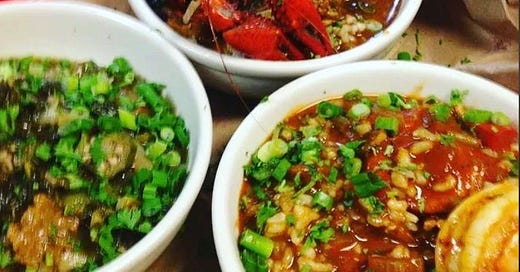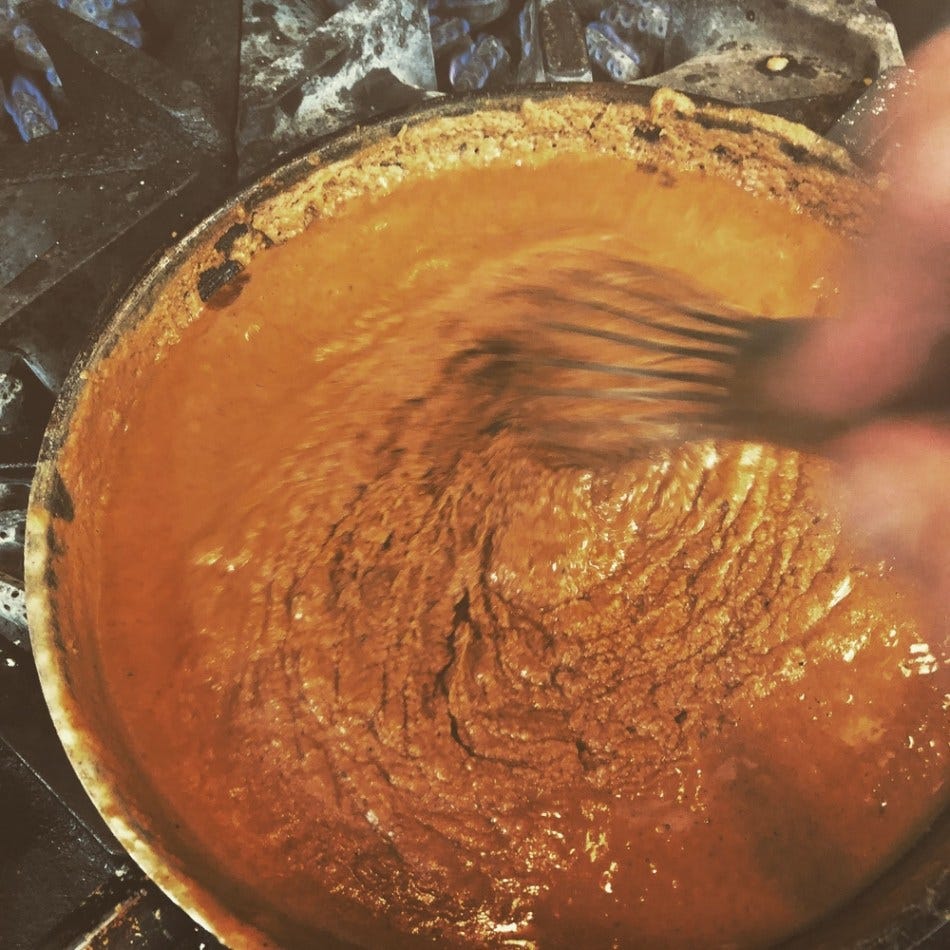I
I fell in love with gumbo way back in the early 1980s when Paul Prudhomme made his groundbreaking appearance on NBC’s Today show. Witnessing the swarthy and beefy Prudhomme, with his thick Cajun accent and funny skimmer hat, making Cajun gumbo on television, was like seeing my first punk rock show. It hit all the notes. It a dark, dirty, spicy, and had an attitude. The early ’80s were an exciting time when we cooks were “allowed” to veer from classic French and Italian cooking into new directions. This was when the American food scene was making its own identity. Cajun-Creole emerged as one of the first “New American Regional” cuisines and it opened the door for the anything-goes food revolution that is still unfolding in the US. From that point forward, I sought to make one of the best gumbos in the Northeast.
There was no internet in the 80s, so I took piles of books from the library and actually taped (yep, VHS!) Justin Wilson making his Ooo-weee! Cajun Country Gumbo on PBS. Eventually, through tweaking of my own, I hit what I was sure was the perfect gumbo with the magical balance of swampiness, earth, tartness, nuttiness, spiciness, and depth of flavor; the whole shebang. It’s a delicious Creole seafood gumbo with shrimp, crab, and crawfish, and a bit of tomato juice. I thicken it with a dark mahogany-colored roux. I also add okra for texture. Finally, just before serving, I sprinkle it with a little File Gumbo powder, just to enhance the earthy aroma.
Over the next 30 years, I served my version of a gumbo in both of my restaurants and at scores of parties. Even friends from New Orleans told me that my gumbo was worthy, which is high praise for this Northeast chef! So then, why do I need a gumbo comeuppance?
Fast forward 30ish years to 2018. I was hosting my first food tour of New Orleans. My group explored music, culture, and, of course, food. On our itinerary was lunch at the landmark Commander’s Palace, the restaurant where both Paul Prudomme and Emeril Lagasse worked and became two of America’s best-known chefs. It was actually my first meal there, and I was as excited as my guests were. Of course, I chose the Commander’s Famous Creole Gumbo for my first course. I was astonished and, yea, a little vindicated by how much my Northeast guy’s gumbo tasted like Commander’s; similar texture and tang and the same depth of flavor.
Later that week, on that NOLA tour, we had a Red Beans and Rice Monday supper experience at Melissa Martin’s up-and-coming speakeasy restaurant, the Mosquito Supper Club. Of course, now her cookbook is a big hit, and the Mosquito Supper Club is one of NOLA’s most difficult reservations to obtain, but back then, it was still a local secret. After our dinner, we chatted a bit about what I did as a chef. I told her about my “New World” menu, which featured an array of some of the world’s best spicy dishes. I cockily mentioned that I made a pretty mean gumbo myself. When she asked what kind of gumbo I made, I made the fatal mistake of replying, “I make a classic Creole gumbo”. ERROR, ERROR! I didn’t realize at the time I was speaking to an expert on Louisiana regional cooking. She abruptly told me that there is no such thing as classic gumbo, filling me in that every parish had its own rendition of gumbo, and within every parish, every family made their own version of that. She told me that I should never use the world classic when referring to gumbo. I felt like a real carpetbagger. This was when the real Gumbo homework began for me.
In the spring of 2019, I was in Taormina, Sicily. I had finished hosting my first tour of Sicily and was staying in for another week to explore for future tours. One sultry night I was strolling the town, walking off my multicourse dinner. I sat at a small table in an outdoor cafe for a coffee. At the table next to me, there was a fiery blonde woman chattering into her cellphone with what I immediately identified as a New Orleans accent. When she hung up, I leaned over and said “Thank you.” She just looked at me with a puzzled and slightly put-off expression. I clarified my comment by explaining that I hadn’t heard American English in a week and how it was oddly soothing to my frazzled brain. I introduced myself as a chef from New York and asked if she was also in the business.
By serendipitous chance, the woman was Amy Sins, a New Orleans celebrity chef. She was also hosting a tour of Sicily. We eased into a polite conversation, talking about Sicilian food, Nola, and my hometown, Woodstock. Then, as it always happens when talking with someone from Louisiana, the subject came to gumbo. I told her the story of my “Classic Gumbo” comment at Mosquito Supper Club. I took a chance. I hoped I might gain a little sympathy or at least empathy, but no go. As I explained my use of roux, okra, and file powder, she pounced, schooling me on gumbo thickening rules.
“First off, you can only use two out of three thickeners, roux, okra, or file powder. You should NEVER use all three, EVER. It ain’t gumbo if you mess that part up.” Well, apparently, I was messing it up as I used all three thickeners in my gumbo. Then she asked me the trap door question.
“Do ya’ll use tomatoes in your gumbo?”
“ I do, sorta,” I said self-consciously. “I used to use tomatoes, then I switched to tomato juice, but now I use a little V-8 juice. It gives it so much pop.”
She smacked me back in an authoritative voice, “Y’all ain’t making gumbo, my friend. I bet it’s tasty, but it ain’t gumbo if there are tomatoes in it.”
Having done my research, I foolishly decided to push this beating further.
“But doesn’t Creole seafood gumbo have tomatoes in it?” I responded brashly.
“Yea, it might, but….” She proceeded to educate me on how home cooks who use meat and game in their gumbo only thicken with roux, whereas others who specialize in chicken gumbo only use okra. And some real country folk use File Gumbo powder and sassafras exclusively.
I had to keep prying. “Sounds like the food in Sicily. Every village has its way of making things, and every home in that village has its own twist.”
She was a like a dog with a bone, “But y‘all need to understand that for Cajuns, Gumbo is almost sacred in its traditions.”
“Like Neapolitans with Pizza?” I asked with a smirk.
“Ok, yea, but there is good pizza in a lot of places,” she said.
Yep, and there is good gumbo in a lot of places too.
Your kitchen is a good place to start.
You can taste my Gumbo and more at my Pre Mardi Gras Pop Up Dinner at the Den in Albany! https://www.thedenalbany.com/events/ric-orlandos-supper-club-at-the-den-p288h
Here are my two gumbo recipes. One for my Creole Seafood Gumbo and one for a Cajun Chicken and Sausage Gumbo. Mardi Gras is March 4th. You have plenty of time. Cook your gumbo and enjoy every bite! And get your Gumbo Comeuppance by making it yourself!
Keep reading with a 7-day free trial
Subscribe to Think About Food to keep reading this post and get 7 days of free access to the full post archives.






